#roesel's bush cricket
Photo

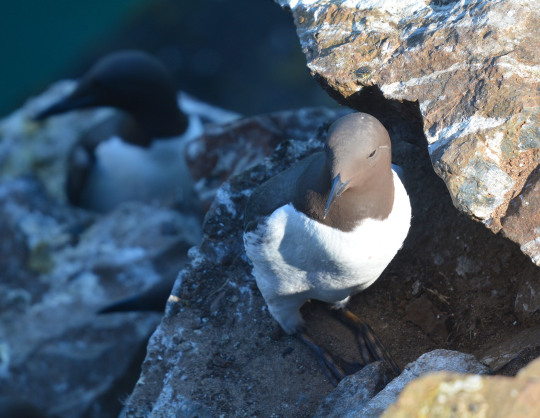



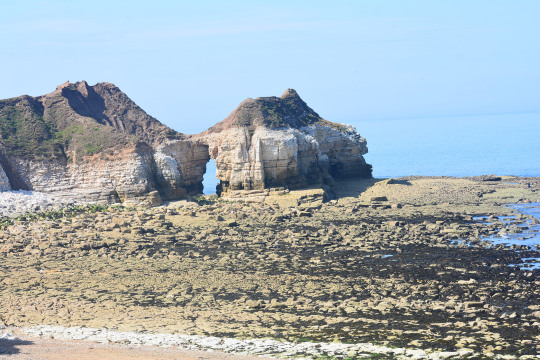




Post ten of my wildlife and photography highlights blogs 2022: Summary of our wildlife holidays/time away this year: Seabirds, Bee-eaters, butterflies and more
It was another stellar line up of three holidays/trips away this year which took me to some of the most wonderful wild places in the UK. The two weeks away in April to Pembrokeshire and June to Yorkshire were both big seabird watching experiences at their heart some of my very favourite wildlife to watch and the first birds I loved and they were some of my best ever moments with some of my favourite birds. It really did feel like pinnacles of my year when immersed in the seabird colonies of Skomer Island a place I adore the centre piece for Pembrokeshire and RSPB Bempton Cliffs another astonishing location the centre piece of our Yorkshire trip. The Puffins of course starred on both seeing these clown faced wonders so intimately gearing up for nesting season on Skomer Island was an honour again this experience swells my heart, seeing them embedded in clumps of sea campion with one pooing right in front of us was fantastic I took the first picture in this photoset of one on Skomer and we saw them well in Yorkshire. The Gannets took centre stage in Yorkshire being mesmerised by seeing these enormous birds in flight so closely and on the cliff including bill rubbing seeing young birds too I took the fifth picture in this photoset of some from Bempton. Razorbill in one of my strongest ever years for seeing this big favourite bird of mine, Guillemot as shown in the second picture in this photoset on Skomer, Kittiwake and Fulmar were ones we saw phenomenally on both trips too, with Chough and Manx Shearwater key stars of the Pembrokeshire adventure. Skomer also brought me perhaps my moment of the year when unexpectedly another of the birds I adore and loved very much early on an Osprey flew over whilst I was looking at Puffins and the other seabirds and then Bempton Cliffs’ answer to that almost was of course us seeing the iconic Albie the rare Black-browed Albatross a sensational experience. They really were two weeks of splendour and a glorious natural spectacle observing the hustle and bustle of these seabird colonies. There were poignant undertones of just enjoying this and feeling so lucky to with bird flu devasting many colonies in this country.
The Pembrokeshire trip came at the height of spring migration so we managed to pick up a lot of other year ticks across the county and wider Wales including Wheatear seen a lot, Dipper, Common Sandpiper and Willow, Sedge and Reed Warbler all becoming some of many stars of the trip and this along with the seabirds helped my year list surge ahead of how many I had seen on the date in all of my previous years which stood out this year. If that’s a tag line from Pembrokeshire then Yorkshire’s was that it was more towards the time young birds were about with a few of them seen, but it wasn’t without its bonus year ticks with my first Tree Sparrows for four years, Common Scoter and Whinchat stars of the trip.
Both these holidays were at simply breathtaking locations in my favourite type of habitat that dramatic coastline I took the third picture in this photoset of a view from Skomer Island and sixth of Thornwick Bay in Yorkshire, with us staying in lovely places at both with lots of wildlife around and a brilliant variety of places visited crossing into other habitats like dramatic watery woodland walks and the North York Moors. Both trips had big mammal moments in my amazing year for seeing marine mammals especially Grey Seals and Harbour Porpoises seen on both two I adore I took the seventh picture in this photoset of Grey Seals. Both trips were significant for my butterfly year with amazing species seen like Dingy Skipper in Pembrokeshire and Small Pearl-bordered Fritillary in Yorkshire as shown in the eighth picture in this photoset at Fen Bog nature reserve at different parts of the season. Both were big flower trips with the notable thing about Pembrokeshire being how the flower season jumped ahead as I was seeing species I expected a few weeks or months down the line at home from red campion to oxeye daisy as shown in the fourth picture in this photoset at Stackpole with thrift, squill and scurvygrass key coastal ones seen and in Yorkshire great willowherb, chamomile and northern marsh orchid starred as it was an addition to the going into summer species at home at that time. Full of inspiration I took so many photos of all the different aspects of both wildlife and landscape, they really were key times in my year.
It was amazing to visit the Global Bird Fair at Rutland Showground in July a pleasant re-birth of this event we loyally attended from 2008-2019. It was an amazing weekend with the spirit of the event, all the valuable social interaction it allowed me to have and all for a good nature conservation cause all very much back. We took a detour to Norfolk on the way to see the history making Bee-eaters who nested at a quarry near Trimingham one of my valued list of new bird species I saw this year a list with some crackers on I took the tenth picture in this photoset of one. This led the highlights in a marvellous weekend of birdwatching with my first Water Rail and Yellow-legged Gull of the year seen at the Rutland Water nature reserves where we also went that weekend and of course Ospreys again in a very strong year I had for them with some captivating moments seeing them, Sedge Warbler, Marsh Harrier, Great White Egret, Kingfisher, Common Crane, a Bittern flying, Egyptian Geese, Bullfinch, Wood, Green and Common Sandpiper, Avocet, Little Ringed Plover and Wren chicks starring across the Rutland and Norfolk locations as we visited Hickling Broad too with a Sparrowhawk being ringed at the Bird Fair ringing demonstration a smashing moment to see that stuck in the mind. At the beginning of the Big Butterfly Count it was an incredible weekend of butterflies with me enjoying doing the counts and also seeing my first ever Essex Skipper at Hickling Broad as well as Purple Hairstreak, Small Copper, Painted Lady, Gatekeeper, Meadow Brown, Small Skipper, Peacock, Red Admiral and Comma other highlights. Muntjac Deer by a road and Fox and lots of hemp agrimony and bird vetch were highlights in a top weekend of mammals and flowers, and it was also a pivotal moment in my dragonfly year with Brown Hawker and Ruddy Darter added to the year list and seen so much in Rutland and Norfolk wonderful species. There were some good other wildlife moments like seeing Roesel’s bush cricket and moths like Common Nettle-tap, I took so many photos of the beautiful landscape as the ninth picture in this photoset shows and wildlife and it all came in one of the hottest parts of the year in a heatwave in this hot and dry summer making for a very unique experience. In all three trips away we were very lucky with the weather seeing so much of the sunshine, these were wonderful spring and summer memories in two relaxing and packed weeks away and one happy long weekend.
A key post I did about each at the time are:
https://dansnaturepictures.tumblr.com/post/682811257713246208/28042022-skomer-island-blog-1-of-2-the
https://dansnaturepictures.tumblr.com/post/687615349094580224/20th-june-2022-bempton-cliffs-post-one-of-two-the
https://dansnaturepictures.tumblr.com/post/690140439866638336/16072022-the-global-bird-fair-in-rutland-and
#birdwatching#nature#photography#uk#birds#seabirds#pembrokeshire#skomer island#roesel's bush cricket#rspb#rspb bempton cliffs#norfolk#rutland#yorkshire#happy#flowers#butterflies#mammals#landscapes#insects#flower#puffin#guillemot#kittiwake#gannet#fulmar#razorbill#sedge warbler#dipper#whinchat
3 notes
·
View notes
Text



Roesel's bush-cricket /Скачок Резеля/ (female)
Sometimes I photograph insects. This is one of my hobbies. I try to recognize the species of the photographed insect. It's quite an interesting thing~ uwu (Let me get ahead of your question - I am not afraid of insects. I know which of them can cause serious damage, so I don’t directly touch wasps, hornets, etc.)
#asterus19#jestanaia banka#photography#photo#Roesel's bush-cricket#bush-cricket#insect#green#female#Roeseliana#grasshopper#bugs#кузнечик#Скачок Резеля
22 notes
·
View notes
Text

Roesel's Bush-cricket
A Roesel's bush-cricket climbing up a vetch stem, at Summer Leys.
#canon#canonuk#fauna#insect#insects#invertebrate#invertebrates#metrioptera roeselii#minibeast#minibeasts#nature#nature reserve#northamptonshire#northants#outdoors#roesel's bush-cricket#summer leys#wildlife#wildlife trust#wildlife trusts#wildlifebcn
8 notes
·
View notes
Text




Orthoptera - Decticus verrucivorus, Chorthippus albomarginatus, Roeseliana roeselii
#insects#orthoptera#grasshopper#cricket#insecta#tw insects#katydids crickets#tettigoniidae#Wart-biter#Roesel's Bush-cricket#Lesser Marsh Grasshopper#acrididae
3 notes
·
View notes
Text

Grasshopper of….. Some sort!
#Grasshoppers are a bit more tricky to properly identify compared to some other insects#it MIGHT be a bog bush cricket or roesels bush cricket but… not confident enough to say!#in more fun news: the local name for them essentially means ‘jumping rooster’!#Featured Creatures#Grasshopper#bugs
1 note
·
View note
Text
Butterflies and Dragonflies in Greenwich
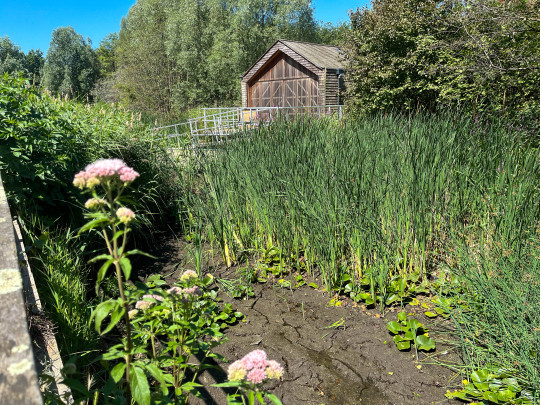
View On WordPress
#Black-Tailed Skimmer#Common Darter#Common Tern#Greenwich Ecology Park#Marbled White#Roesel&039;s Bush-cricket#Vanbrugh Pits
0 notes
Note
I translated some of my Warrior OCs a bit ago! Four of them are part of one family, and the other is my tabaxi ranger with a warrior's name! I don't know if they're correct, but I wanted to give it a shot!
Clovershine - Glemshem (Her name ended up super cute to say! She's the Mi of Cricket and Fawn!)
Alderpelt - Reykossaborrl (There wasn't a word specifically for Alder, so I combined red and tree! This guy is Clover's mate and the very involved Ba of Cricket and Fawn!)
Fawnfrost - Myaachiki (Myaa sounded cuter than Mween, so I used that instead! Fawny is my main girl I rped and invested a lot of trauma in! :D)
Cricketcall - ???ayeo (Sadly no word for cricket, and I couldn't find words to combine for it. Maybe bell and bug? Idk, I just think this guy is neat! He and his dad and Fawn's mentor all die in a terrible sickness, hence her trauma! :DD)
Emberstrike - Kipkubo (A bit of a stim of a name, tbh. She's the ranger, I love her so much and I wish her campaign didn't fall through...)
CRICKET TIME.
So the first thing to know here is that the Clan cat idea of crickets may be somewhat different to your own.
If you're American, you may have a distinction in your mind that a cricket is usually a singing, hopping bug with a more rounded head, where grasshoppers are longer and more locust-shaped. That isn't the case in this part of Britan/Albion. In fact, grasshoppers are the ones better known for their singing abilities.
See this?

This is a house cricket. They're very rare in this region, and mostly live in human houses, as the name implies. Clan cats do not have a word for these.
THIS is what they're imagining when they hear the word cricket;
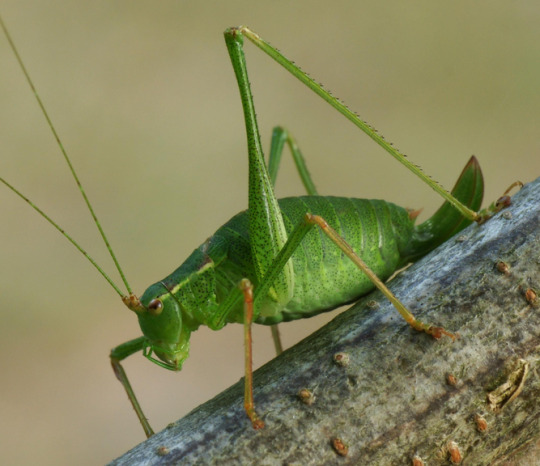
This green, stout, long-legged insect is called a Speckled Bush-Cricket. They have three species of bush-cricket and five species of hopper.
Generic terms;
Bush-cricket (generic) = Pwoi
Named for the sound they make while jumping, as opposed to how hoppers are named for the song. Sometimes gets applied to other rounded, hopping insects, like fleas.
Hopper (generic) = Chrriga
Long, powerful insects with loud chirping wails that they make by rubbing their legs against themselves. Found on the ground and in grass, unlike bush-crickets which are usually arboreal.
Popper (a hopping insect suitable for eating) = Arroi
Subjective, WindClan tends to use this as a generic for both hoppers and bush-crickets, ShadowClan applies it to all big ones, RiverClan and ThunderClan don't use it at all (except Sorreltail who uses it for any hoppers she's caught and plans to eat).
Hopper Poppers = Pwoi k'sirArroi
A WindClan dish. Mashed, breaded-and-egged, deep fried cricket balls. Related to grubcakes, but these INCLUDE breadcrumbs for a crunch. Kind of unhealthy, but a good source of fat which is otherwise lacking in the WindClan diet.
Specific species;
For funsies I'm going to give them a culinary rating, maximum of four stars ⭐⭐⭐⭐. I'm being possessed by the spirit of BB!Sorreltail lmao.
Roesel's bush-cricket (Roeseliana roeselii) = I'ri'r
THE undeniable sound of summer, buzzing long and loud when it gets hot. This animal is the most uncanny mix between a hopper and a bushcricket and has a distinctive sound, so it's rarely referred to with a generic title.
⭐⭐⭐
It is also large and meaty. Best of both worlds, right here. Most palatable bush-cricket.
Speckled bush-cricket (Leptophyes punctatissima) = Rr'ik
Though its cry is delicate and high-pitched like a bat, it's noteworthy for being the only one in this family that sings mutually. Female crickets return a song to a male they like.
⭐⭐
They're small, but gooey. WindClan sometimes skips mashing them because they're SO leggy, they prefer to just pull the bits off and eat the body. Like a gusher. But that's so much effort, you know?
Drumming Katydid (Meconema thalassinum) = Kugr
Has a low, almost threatening grinding noise, which is fitting because it is an active predator. The only one in this list. It kills and eats caterpillars and other invertebrates, but that's not all. It's also a host for a horrible parasite that forces it to run towards water at the end of its life, drowning the animal before bursting out of its body.
⭐
Tastes awful. Possessed by worms. All legs and no meat. Only ShadowClan would eat something like this.
Common Field Grasshopper (Chorthippus brunneus) = Gyig
WindClan's bread-and-butter, one of the most common insects they need to eat to keep their coats healthy. Has a chirping song instead of a drawn-out one. HATES wetness and is best found where the gorse is dead and dry.
⭐⭐⭐⭐
A favorite for a reason. It's abundant, it's meaty, it's large. It can even be purple.
Green Grasshopper (Omocestus viridulus) = F'fir
Green with thick black bars on its abdomen, with a harsh, fluttering song. Tends to find a high pedestal before playing its song, as if it's trying to get in front of an audience.
⭐⭐⭐
Has more crunch than meat, with big wings that can get in the way, but still a hopper which is pretty delicious.
Slender grouse locust (Tetrix subulata) = Sswoi
Dull brown thing that doesn't even sing. Has a dumb little wiggle-dance instead. Loves streams and lidos and is the hopper that RiverClan cats see most often.
⭐
No wonder RiverClan doesn't eat bugs.
Meadow Grasshopper (Pseudochorthippus parallelus) = Shriga
Some of them can look deceptively like a f'fir with the green bodies and barring, but listen. Listen. Its song is TOTALLY different, more of a shakey-shake kind of rattle.
⭐⭐⭐⭐
And Sorreltail will GO TO BAT for how delicious they are. Don't be fooled. This is grasshopper ambrosia. Tiny wings, lots of crunch, a nice flavor. ABSOLUTE delicacy.
Groundhopper (Tetrix undulata) = Wariga
A plump, brown grasshopper that eats moss and algae, preferring wet environments with drier areas to retreat to.
⭐⭐⭐??? Data needed.
ShadowClan cats kept SWEARING to Sorreltail that these are actually the best, most delicious poppers out there. But she's never had one so she can't attest to it... yet. It's hard to imagine anything can taste better than a honey-roasted shriga. She doubts it tbh.
#crickets#bush-crickets#grasshoppers#Clanmew#Insects#insect pictures#bug pictures#cw bugs#cw insects
43 notes
·
View notes
Text
“It fascinates and saddens me,” he said. “Our wildlife surveys have shown that climate change isn’t something that will happen in the distant future. Most of the crickets you hear calling in the meadows have only been in Bath for the past 20 years or so – these are Roesel’s bush-cricket and long-winged conehead. The former is very loud and very numerous. I tell people on my nature walks around the farm that they are listening to the sound of climate change when we hear them.”
2 notes
·
View notes
Text

Roesel's Bush-cricket, Roeseliana roeselii Canon 400D EF 100 2.8 f/4 1/200 iso:200 Celakovice-Jirina, Czech Republic June 24, 2012
#hoppers#Grassppers#Crickets#Tettigoniinae#Orthoptera#insects#invertebrates#Macro#insect#macrophotography#insectphotography#macro
0 notes
Photo
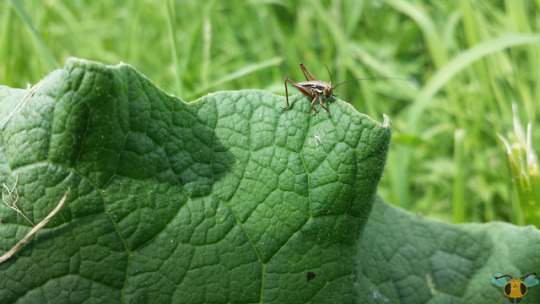

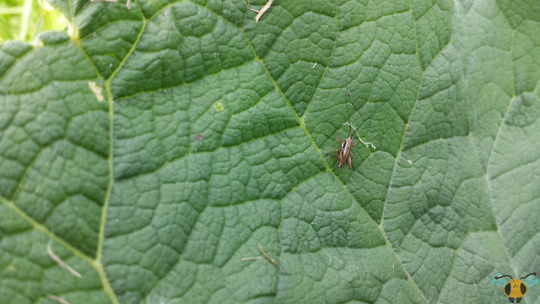


Roesel’s Bush Cricket - Metrioptera roeselii
As promised last week, here is the follow-up to my first encounter with Roesel’s Bush Cricket, this one found at the Royal Botanical Gardens’ Princess Point. Just found it on accident, climbing up this rather large leaf. Unlike the post from last week however, this Katydid is a male; males lack ovipositors (since they can’t lay eggs), so their rear doesn’t have a large blade jutting out. Nevertheless, it’s a fairly robust Katydid, though definitely not the largest specie I’ve seen. While this Katydid is in its adulthood, it can still grow much larger and have more saturated colors. It’ll blend into the foliage well, perhaps more so with the nearby trees bordering this grassy forest, although, I’ve read that this Katydid prefers to hide and feed in long grasses. Like its relative, the Drumming Katydid, this Bush-Cricket isn’t actually from around here. Both of these bachelors originate from Europe and have found their way here. The species don’t seem to have upset the ecosystem, but a long term search would have to be done for that, and right now I’m still only gathering data.
Looking for info on this specie, I’ve found that individuals like this one don’t have to be restricted to shortened or lack of wings. Some Katydids of this specie can grow wings the size of those of Red-Legged Grasshoppers, though the reason why isn’t fully understood. Either way, the larger wings aren’t just for show; they have powerful flight muscles to help them get around. The technical term for Katydids like this called, “marcopterous form”. The default Roesel’s Bush Cricket form with reduced wings is referred to as a “brachypterous form”. To conclude, while talking about long names, if you’re wonder who “Roesel” is (the Katydid’s namesake), he is a German entomologist from the 1700′s renowned for detailed images of insects. His full name was August Johann Rosel von Rosenhof. Certainly a worthy figure to be named after. Maybe we should name one insect from each order after him? Just a thought. Keep an eye out for these Bush Crickets until then, summer is their time to sing.
Pictures were taken on June 9, 2019 at the Royal Botanical Gardens with a Samsung Galaxy S4
#jonny’s insect catalogue#insect#roesel's bush cricket#katydid#bush cricket#orthoptera#royal botanical gardens#june2019#2019#ontario insect#entomology#nature#invertebrates#arthropods
0 notes
Photo

Roesel's bush-cricket and marbled white by oberfranke
1 note
·
View note
Text






17/08/2024-Beautiful fuchsia in the garden and from our visit to Shipton Bellinger today stunning Wall Brown, a smashing view, upright hedge-parsley, a gorgeous Brown Hairstreak one of my first of the year it was amazing to see this exuberant species for a fourth year running here today having never seen one prior to 2021 I feel so lucky and scabious.
Other highlights at Shipton Bellinger were Brown Argus, Small Heath, Meadow Browns, Brimstones, Speckled Wood, Fox moth and Cinnabar moth caterpillars, bees, Roesel's bush cricket, Raven, Red Kite, Buzzard, Kestrel, Bullfinches, Chiffchaff, rosebay willowherb, a fair few precious harebells, self-heal, wild basil, St. John's-wort, red bartsia, eyebright, centaury, viper's-bugloss, bramble flower and blackberries, my first ever buckthorn berries, the characteristic wayfaring tree berries of this site, hawthorn berries and cuckoo-pint berries with Green Woodpecker heard and Goldfinch and Woodpigeon enjoyed at home.
#photography#scabious#wall brown#brown hairstreak#speckled wood#brimstone#brown argus#raven#red kite#woodpigeon#goldfinch#red bartsia#eyebright#2024#august#summer#outdoors#europe#birdwatching#butterflies#hampshire#wiltshire#outside#home#walking#wildlife#weekend#happy
9 notes
·
View notes
Text

Roesel's Bush-cricket
A very green Roesel's bush-cricket, hanging out amongst the bramble leaves in Southwick Wood.
#canon#canonuk#insect#insects#invertebrate#invertebrates#minibeast#minibeasts#nature#nature reserve#northamptonshire#northants#outdoors#roesel's bush-cricket#roeseliana roeselii#roesels bush-cricket#short and southwick woods#short wood and southwick wood#summer#wildlife#wildlife trust#wildlife trusts#woodland#woods
0 notes
Photo





Invertebrates Amwell Nature Reserve
0 notes
Text


bugz that a friend sent me :) the first is a grapevine beetle and the second is roesel’s bush cricket <3
3 notes
·
View notes
Photo

Roesels bush cricket by oberfranke Aerials Harrogate
0 notes